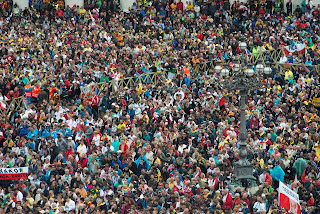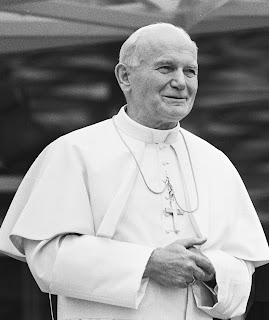Crowd of 800,000 in St Peter's Square for joint canonisation
 |
| The Basilica of St Peter, in readiness for the joint-canonisation of Popes John XXIII and John Paul II in 2014 |
Pope Francis declared Pope John XXIII and Pope John Paul II
as saints at a ceremony during Mass in Rome’s St Peter’s Square on this day in
2014.
Hundreds of thousands of people from around the world converged
on the Vatican to attend the ceremony, which celebrated two popes recognised as
giants of the Catholic Church in the 20th century.
There was scarcely room to move in St Peter's Square, the Via della Conciliazione and the adjoining streets. The crowd, probably the biggest since John
Paul II’s beatification three years earlier, was estimated at around 800,000,
of which by far the largest contingent had made the pilgrimage from John Paul’s
native Poland to see their most famous compatriot become a saint. Thousands of red and white Polish flags
filled the square.
In his homily, Pope Francis said Saints John XXIII and JohnPaul II were “priests, bishops and popes of the 20th century. They lived
through the tragic events of that century, but they were not overwhelmed by
them. For them God was more powerful, faith was more powerful”.
He added that the two popes had “co-operated with the Holy
Spirit in renewing and updating” the Catholic Church.
 |
| Pope Francis delivers his homily to the crowd in the square |
Among those attending this morning’s Mass was Pope Emeritus,
Benedict XVI, who in 2013 had become the first pope to resign in 600 years.
Among the foreign dignitaries present, which included 19
heads of state and 25 heads of government, was the former Polish president,
Lech Walesa, who had been a key figure in the fall of communism as leader of
the Soviet bloc’s first independent trade union, Solidarity.
Italy was represented by the prime minister, Matteo Renzi, the
president, Giorgio Napolitano, and his wife, first lady Clio Maria Bittoni.
Other world leaders present included Spain’s King Juan
Carlos I and Queen Sofia, the French prime minister Manuel Valls, and the
controversial Zimbabwean president, Robert Mugabe.
St Peter’s Basilica was opened to allow pilgrims visit the
tombs of both new saints, which rest in crypts inside the building.
Both John XXIII, who was in office from 1958 to 1963 and
called the modernising Second Vatican Council, and John Paul II, who
reigned for nearly 27 years, played leading roles on the world stage.
 |
| Every space in St Peter's Square was taken |
John XXIII, born Angelo Giuseppe Roncalli in Sotto il Monte,
near Bergamo, in 1881, was known as the “Good Pope” because of his friendly,
open personality. He died before the Second Vatican Council ended its work in
1965 but his initiative had set off a significant upheaval in church teaching, ending
the use of Latin at Mass, introducing modern music and opening the way for
challenges to Vatican authority.
John Paul, born Karol Józef Wojtyła in Wadowice in 1920, was
widely credited with helping to bring down communist rule in eastern Europe and
hastening the end of the Cold War.
As pope he continued with reform but tightened central
control, condemned theological renegades and preached a strict line on social
issues such as sexual freedom. Although a charismatic character, he was
criticised by some for being too conservative.
 |
| Pope John Paul II was idolised by many Catholics |
However, he was able to inspire adoration from many
Catholics, as was witnessed when the crowd at his funeral in 2005 joined in a
spontaneous chant of “santo subito”, urging that he be made a saint immediately.
Although that did not happen, he was honoured with the fastest declaration of
sainthood in modern history.
Among those less enamoured with his canonisation were a
group who claimed to have been the victims of sexual abuse by priests, who felt
John Paul II did not do enough to tackle the problem, particularly with regard
to the controversial Mexican founder of the Legion of Christ, Father Marcial
Maciel Degollado, whom John Paul’s successor, Benedict XVI, removed from active
ministry soon after beginning his papacy.
The group staged a rooftop vigil nearby.
Both canonisations had involved adaptation of the strict rules governing declaration of a saint, which normally involve the
attestation of at least two miracles.
In the case of John Paul II, Benedict XVI had waived the customary
five-year waiting period before the preliminaries to sainthood can begin, while
Francis ruled that only one miracle was needed to declare John a saint.
 |
| The Via della Conciliazione at night |
Travel tip:
The Via della Conciliazione, in the rione (district) of
Borgo, is the street that connects St Peter's Square to Castel Sant'Angelo
on the western bank of the Tiber river. Bordered by shops, historical and
religious buildings including the churches of Santa Maria in Traspontina and
Santo Spirito in Sassia, it was built between 1936 and 1950 to fulfil Mussolini’s
vision of a grand thoroughfare into the square but attracted much controversy
because of the destruction of an area known as the ‘spina’ – spine – of Borgo
and the forced displacement of hundreds of residents to locations on the
outskirts of the city.
 |
| The village of Sotto il Monte Giovanni XXXIII |
Travel tip:
Now renamed Sotto il Monte Giovanni XXIII, Pope John’s
birthplace was originally a small farming community to the west of Bergamo. It
has seen much change as a result of Angelo Roncalli’s elevation to the papacy
and subsequent sainthood, attracting many tourists. The house where he was born
is in the hamlet of Brusicco and the summer residence at Camaitino that he used
when he was a cardinal is now a history museum dedicated to him. Also worth visiting nearby, on the slopes of
Monte Canto, is the Romanesque Fontanella Abbey, dating back to the 11th
century.
How Karol Wojytla became the first non-Italian pope for 455 years
The farmer's son who went on to become the 'good pope'
The consecration of St Peter's Basilica
More reading:
How Karol Wojytla became the first non-Italian pope for 455 years
The farmer's son who went on to become the 'good pope'
The consecration of St Peter's Basilica





























